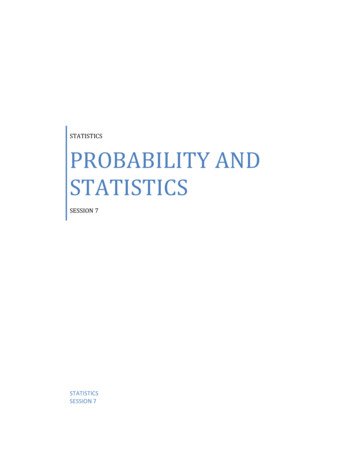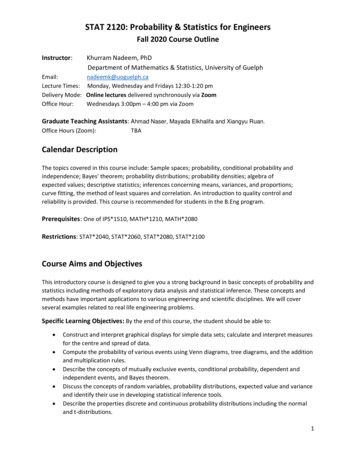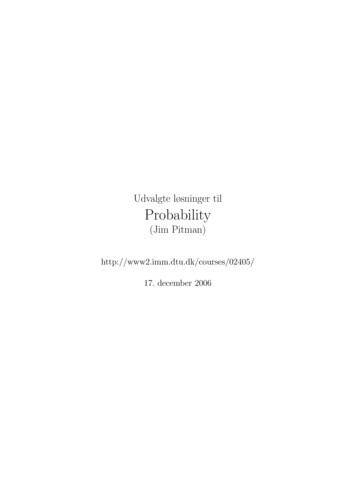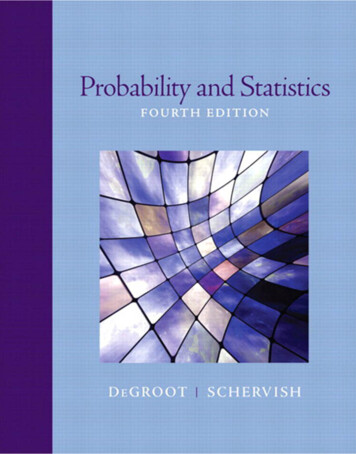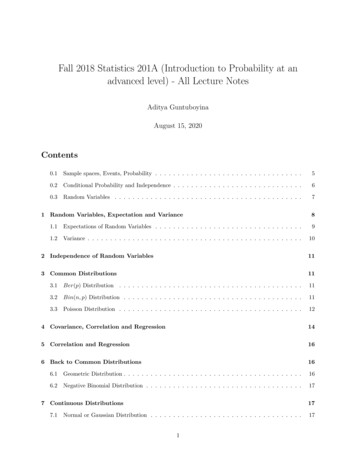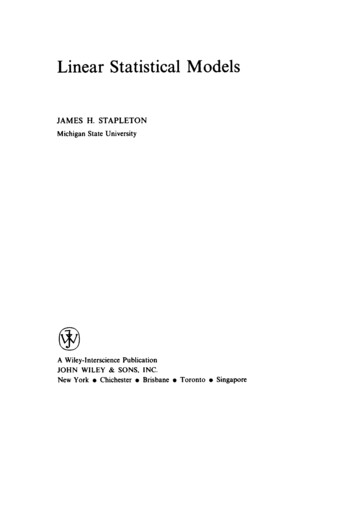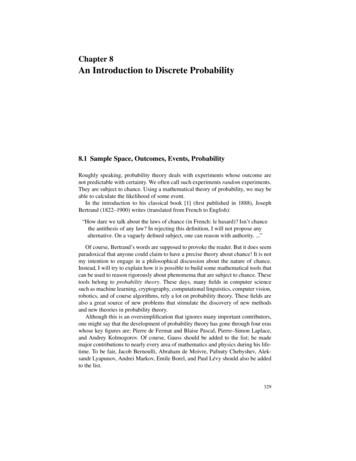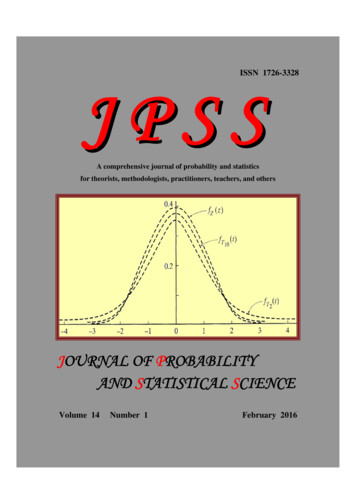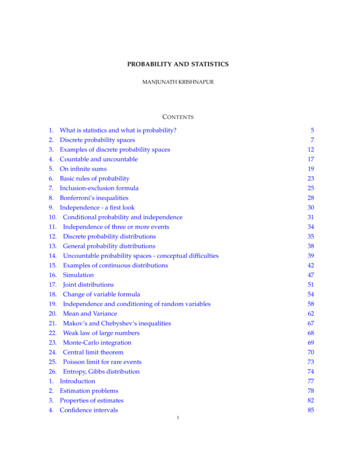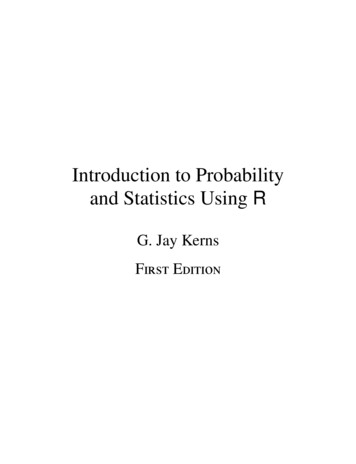
Transcription
Introduction to Probabilityand Statistics Using RG. Jay KernsFirst Edition
iiIPSUR: Introduction to Probability and Statistics Using RCopyright 2010 G. Jay KernsISBN: 978-0-557-24979-4Permission is granted to copy, distribute and/or modify this document under the terms of the GNUFree Documentation License, Version 1.3 or any later version published by the Free Software Foundation; with no Invariant Sections, no Front-Cover Texts, and no Back-Cover Texts. A copy of thelicense is included in the section entitled “GNU Free Documentation License”.Date: March 24, 2011
ContentsPrefaceviiList of FiguresxiiiList of Tablesxv1An Introduction to Probability and Statistics1.1 Probability . . . . . . . . . . . . . . . . . . . . . . . . . . . . . . . . . . . . . . .1.2 Statistics . . . . . . . . . . . . . . . . . . . . . . . . . . . . . . . . . . . . . . . .Chapter Exercises . . . . . . . . . . . . . . . . . . . . . . . . . . . . . . . . . . . . . .2An Introduction to R2.1 Downloading and Installing R . .2.2 Communicating with R . . . . . .2.3 Basic R Operations and Concepts2.4 Getting Help . . . . . . . . . . . .2.5 External Resources . . . . . . . .2.6 Other Tips . . . . . . . . . . . . .Chapter Exercises . . . . . . . . . . . .334612141416Data Description3.1 Types of Data . . . . . . . . . . .3.2 Features of Data Distributions . .3.3 Descriptive Statistics . . . . . . .3.4 Exploratory Data Analysis . . . .3.5 Multivariate Data and Data Frames3.6 Comparing Populations . . . . . .Chapter Exercises . . . . . . . . . . . .1717333541454755Probability4.1 Sample Spaces . . . . .4.2 Events . . . . . . . . . .4.3 Model Assignment . . .4.4 Properties of Probability4.5 Counting Methods . . .4.6 Conditional Probability .6767737883879334.iii1112
ivCONTENTS4.7 Independent Events4.8 Bayes’ Rule . . . .4.9 Random Variables .Chapter Exercises . . . .56789. 99. 102. 106. 109Discrete Distributions5.1 Discrete Random Variables . . . . . . . . . . .5.2 The Discrete Uniform Distribution . . . . . . .5.3 The Binomial Distribution . . . . . . . . . . .5.4 Expectation and Moment Generating Functions5.5 The Empirical Distribution . . . . . . . . . . .5.6 Other Discrete Distributions . . . . . . . . . .5.7 Functions of Discrete Random Variables . . . .Chapter Exercises . . . . . . . . . . . . . . . . . . .111112114116122125128136138Continuous Distributions6.1 Continuous Random Variables . . . . . . .6.2 The Continuous Uniform Distribution . . .6.3 The Normal Distribution . . . . . . . . . .6.4 Functions of Continuous Random Variables6.5 Other Continuous Distributions . . . . . . .Chapter Exercises . . . . . . . . . . . . . . . . .143143148149153157164Multivariate Distributions7.1 Joint and Marginal Probability Distributions . .7.2 Joint and Marginal Expectation . . . . . . . . .7.3 Conditional Distributions . . . . . . . . . . . .7.4 Independent Random Variables . . . . . . . . .7.5 Exchangeable Random Variables . . . . . . . .7.6 The Bivariate Normal Distribution . . . . . . .7.7 Bivariate Transformations of Random Variables7.8 Remarks for the Multivariate Case . . . . . . .7.9 The Multinomial Distribution . . . . . . . . . .Chapter Exercises . . . . . . . . . . . . . . . . . . .165166172174176178179181184186190Sampling Distributions8.1 Simple Random Samples . . . . . . . . . . . . .8.2 Sampling from a Normal Distribution . . . . . .8.3 The Central Limit Theorem . . . . . . . . . . . .8.4 Sampling Distributions of Two-Sample Statistics8.5 Simulated Sampling Distributions . . . . . . . .Chapter Exercises . . . . . . . . . . . . . . . . . . . .191192193196197200203.Estimation2059.1 Point Estimation . . . . . . . . . . . . . . . . . . . . . . . . . . . . . . . . . . . . 2059.2 Confidence Intervals for Means . . . . . . . . . . . . . . . . . . . . . . . . . . . . 2149.3 Confidence Intervals for Differences of Means . . . . . . . . . . . . . . . . . . . . 221
CONTENTSv9.4 Confidence Intervals for Proportions9.5 Confidence Intervals for Variances .9.6 Fitting Distributions . . . . . . . . .9.7 Sample Size and Margin of Error . .9.8 Other Topics . . . . . . . . . . . . .Chapter Exercises . . . . . . . . . . . . .22322522522522722810 Hypothesis Testing10.1 Introduction . . . . . . . . . . . . . . . . .10.2 Tests for Proportions . . . . . . . . . . . .10.3 One Sample Tests for Means and Variances10.4 Two-Sample Tests for Means and Variances10.5 Other Hypothesis Tests . . . . . . . . . . .10.6 Analysis of Variance . . . . . . . . . . . .10.7 Sample Size and Power . . . . . . . . . . .Chapter Exercises . . . . . . . . . . . . . . . . .22922923023523924124124324811 Simple Linear Regression11.1 Basic Philosophy . . . . . .11.2 Estimation . . . . . . . . . .11.3 Model Utility and Inference .11.4 Residual Analysis . . . . . .11.5 Other Diagnostic Tools . . .Chapter Exercises . . . . . . . . .24924925326226727528312 Multiple Linear Regression12.1 The Multiple Linear Regression Model .12.2 Estimation and Prediction . . . . . . . .12.3 Model Utility and Inference . . . . . . .12.4 Polynomial Regression . . . . . . . . .12.5 Interaction . . . . . . . . . . . . . . . .12.6 Qualitative Explanatory Variables . . .12.7 Partial F Statistic . . . . . . . . . . . .12.8 Residual Analysis and Diagnostic Tools12.9 Additional Topics . . . . . . . . . . . .Chapter Exercises . . . . . . . . . . . . . . .28528528829629930430731031231331713 Resampling Methods13.1 Introduction . . . . . . . . . . .13.2 Bootstrap Standard Errors . . . .13.3 Bootstrap Confidence Intervals .13.4 Resampling in Hypothesis TestsChapter Exercises . . . . . . . . . . .319319321326328332.14 Categorical Data Analysis33315 Nonparametric Statistics335
viCONTENTS16 Time Series337A R Session Information339B GNU Free Documentation License341C History349D DataD.1 Data Structures . . . .D.2 Importing Data . . . .D.3 Creating New Data SetsD.4 Editing Data . . . . . .D.5 Exporting Data . . . .D.6 Reshaping Data . . . .351351356357357359359E Mathematical MachineryE.1 Set Algebra . . . . . . . . . . .E.2 Differential and Integral CalculusE.3 Sequences and Series . . . . . .E.4 The Gamma Function . . . . . .E.5 Linear Algebra . . . . . . . . .E.6 Multivariable Calculus . . . . .361361362365368368369F Writing Reports with RF.1 What to Write . . . . .F.2 How to Write It with RF.3 Formatting Tables . . .F.4 Other Formats . . . . .373373374377377G Instructions for InstructorsG.1 Generating This Document .G.2 How to Use This Document .G.3 Ancillary Materials . . . . .G.4 Modifying This Document .379380381381382.H RcmdrTestDrive Story383Bibliography389Index395
PrefaceThis book was expanded from lecture materials I use in a one semester upper-division undergraduate course entitled Probability and Statistics at Youngstown State University. Those lecture materials, in turn, were based on notes that I transcribed as a graduate student at Bowling Green StateUniversity. The course for which the materials were written is 50-50 Probability and Statistics, andthe attendees include mathematics, engineering, and computer science majors (among others). Thecatalog prerequisites for the course are a full year of calculus.The book can be subdivided into three basic parts. The first part includes the introductions andelementary descriptive statistics; I want the students to be knee-deep in data right out of the gate.The second part is the study of probability, which begins at the basics of sets and the equally likelymodel, journeys past discrete/continuous random variables, and continues through to multivariatedistributions. The chapter on sampling distributions paves the way to the third part, which is inferential statistics. This last part includes point and interval estimation, hypothesis testing, andfinishes with introductions to selected topics in applied statistics.I usually only have time in one semester to cover a small subset of this book. I cover the materialin Chapter 2 in a class period that is supplemented by a take-home assignment for the students. Ispend a lot of time on Data Description, Probability, Discrete, and Continuous Distributions. Imention selected facts from Multivariate Distributions in passing, and discuss the meaty parts ofSampling Distributions before moving right along to Estimation (which is another chapter I dwellon considerably). Hypothesis Testing goes faster after all of the previous work, and by that timethe end of the semester is in sight. I normally choose one or two final chapters (sometimes three)from the remaining to survey, and regret at the end that I did not have the chance to cover more.In an attempt to be correct I have included material in this book which I would normally notmention during the course of a standard lecture. For instance, I normally do not highlight theintricacies of measure theory or integrability conditions when speaking to the class. Moreover, Ioften stray from the matrix approach to multiple linear regression because many of my studentshave not yet been formally trained in linear algebra. That being said, it is important to me forthe students to hold something in their hands which acknowledges the world of mathematics andstatistics beyond the classroom, and which may be useful to them for many semesters to come. Italso mirrors my own experience as a student.The vision for this document is a more or less self contained, essentially complete, correct,introductory textbook. There should be plenty of exercises for the student, with full solutions forsome, and no solutions for others (so that the instructor may assign them for grading). By Sweave’sdynamic nature it is possible to write randomly generated exercises and I had planned to implementthis idea already throughout the book. Alas, there are only 24 hours in a day. Look for more infuture editions.vii
viiiCONTENTSSeasoned readers will be able to detect my origins: Probability and Statistical Inference byHogg and Tanis [44], Statistical Inference by Casella and Berger [13], and Theory of Point Estimation/Testing Statistical Hypotheses by Lehmann [59, 58]. I highly recommend each of those booksto every reader of this one. Some R books with “introductory” in the title that I recommend areIntroductory Statistics with R by Dalgaard [19] and Using R for Introductory Statistics by Verzani[87]. Surely there are many, many other good introductory books about R, but frankly, I have triedto steer clear of them for the past year or so to avoid any undue influence on my own writing.I would like to make special mention of two other books: Introduction to Statistical Thoughtby Michael Lavine [56] and Introduction to Probability by Grinstead and Snell [37]. Both of thesebooks are free and are what ultimately convinced me to release IPSUR under a free license, too.Please bear in mind that the title of this book is “Introduction to Probability and StatisticsUsing R”, and not “Introduction to R Using Probability and Statistics”, nor even “Introductionto Probability and Statistics and R Using Words”. The people at the party are Probability andStatistics; the handshake is R. There are several important topics about R which some individualswill feel are underdeveloped, glossed over, or wantonly omitted. Some will feel the same wayabout the probabilistic and/or statistical content. Still others will just want to learn R and skip allof the mathematics.Despite any misgivings: here it is, warts and all. I humbly invite said individuals to take thisbook, with the GNU Free Documentation License (GNU-FDL) in hand, and make it better. In thatspirit there are at least a few ways in my view in which this book could be improved.Better data. The data analyzed in this book are almost entirely from the datasets package inbase R, and here is why:1. I made a conscious effort to minimize dependence on contributed packages,2. The data are instantly available, already in the correct format, so we need not take timeto manage them, and3. The data are real.I made no attempt to choose data sets that would be interesting to the students; rather, datawere chosen for their potential to convey a statistical point. Many of the data sets are decadesold or more (for instance, the data used to introduce simple linear regression are the speedsand stopping distances of cars in the 1920’s).In a perfect world with infinite time I would research and contribute recent, real data in acontext crafted to engage the students in every example. One day I hope to stumble over saidtime. In the meantime, I will add new data sets incrementally as time permits.More proofs. I would like to include more proofs for the sake of completeness (I understand thatsome people would not consider more proofs to be improvement). Many proofs have beenskipped entirely, and I am not aware of any rhyme or reason to the current omissions. I willadd more when I get a chance.More and better graphics: I have not used the ggplot2 package [90] because I do not know howto use it yet. It is on my to-do list.More and better exercises: There are only a few exercises in the first edition simply because Ihave not had time to write more. I have toyed with the exams package [38] and I believe that
CONTENTSixit is a right way to move forward. As I learn more about what the package can do I wouldlike to incorporate it into later editions of this book.About This DocumentIPSUR contains many interrelated parts: the Document, the Program, the Package, and the Ancillaries. In short, the Document is what you are reading right now. The Program provides anefficient means to modify the Document. The Package is an R package that houses the Programand the Document. Finally, the Ancillaries are extra materials that reside in the Package and wereproduced by the Program to supplement use of the Document. We briefly describe each of them inturn.The DocumentThe Document is that which you are reading right now – IPSUR’s raison d’être. There are transparent copies (nonproprietary text files) and opaque copies (everything else). See the GNU-FDL inAppendix B for more precise language and details.IPSUR.tex is a transparent copy of the Document to be typeset with a LATEX distribution such asMikTEX or TEX Live. Any reader is free to modify the Document and release the modifiedversion in accordance with the provisions of the GNU-FDL. Note that this file cannot beused to generate a randomized copy of the Document. Indeed, in its released form it isonly capable of typesetting the exact version of IPSUR which you are currently reading.Furthermore, the .tex file is unable to generate any of the ancillary materials.IPSUR-xxx.eps, IPSUR-xxx.pdf are the image files for every graph in the Document. Theseare needed when typesetting with LATEX.IPSUR.pdf is an opaque copy of the Document. This is the file that instructors would likely wantto distribute to students.IPSUR.dvi is another opaque copy of the Document in a different file format.The ProgramThe Program includes IPSUR.lyx and its nephew IPSUR.Rnw; the purpose of each is to giveindividuals a way to quickly customize the Document for their particular purpose(s).IPSUR.lyx is the source LYX file for the Program, released under the GNU General Public License (GNU GPL) Version 3. This file is opened, modified, and compiled with LYX, asophisticated open-source document processor, and may be used (together with Sweave) togenerate a randomized, modified copy of the Document with brand new data sets for some ofthe exercises and the solution manuals (in the Second Edition). Additionally, LYX can easilyactivate/deactivate entire blocks of the document, e.g. the proofs of the theorems, the studentsolutions to the exercises, or the instructor answers to the problems, so that the new authormay choose which sections (s)he would like to include in the final Document (again, SecondEdition). The IPSUR.lyx file is all that a person needs (in addition to a properly configured
xCONTENTSsystem – see Appendix G) to generate/compile/export to all of the other formats describedabove and below, which includes the ancillary materials IPSUR.Rdata and IPSUR.R.IPSUR.Rnw is another form of the source code for the Program, also released under the GNU GPLVersion 3. It was produced by exporting IPSUR.lyx into R/Sweave format (.Rnw). This filemay be processed with Sweave to generate a randomized copy of IPSUR.tex – a transparentcopy of the Document – together with the ancillary materials IPSUR.Rdata and IPSUR.R.Please note, however, that IPSUR.Rnw is just a simple text file which does not support manyof the extra features that LYX offers such as WYSIWYM editing, instantly (de)activatingbranches of the manuscript, and more.The PackageThere is a contributed package on CRAN, called IPSUR. The package affords many advantages, onebeing that it houses the Document in an easy-to-access medium. Indeed, a student can have theDocument at his/her fingertips with only three commands: install.packages("IPSUR") library(IPSUR) read(IPSUR)Another advantage goes hand in hand with the Program’s license; since IPSUR is free, the sourcecode must be freely available to anyone that wants it. A package hosted on CRAN allows the authorto obey the license by default.A much more important advantage is that the excellent facilities at R-Forge are building andchecking the package daily against patched and development versions of the absolute latest prerelease of R. If any problems surface then I will know about it within 24 hours.And finally, suppose there is some sort of problem. The package structure makes it incrediblyeasy for me to distribute bug-fixes and corrected typographical errors. As an author I can make mycorrections, upload them to the repository at R-Forge, and they will be reflected worldwide withinhours. We aren’t in Kansas anymore, Toto.Ancillary MaterialsThese are extra materials that accompany IPSUR. They reside in the /etc subdirectory of thepackage source.IPSUR.R is the exported R code from IPSUR.Rnw. With this script, literally every R commandfrom the entirety of IPSUR can be resubmitted at the command line.NotationWe use the notation x or stem.leaf notation to denote objects, functions, etc. The sequence“Statistics . Summaries . Active Dataset” means to click the Statistics menu item, next click theSummaries submenu item, and finally click Active Dataset.
CONTENTSxiAcknowledgementsThis book would not have been possible without the firm mathematical and statistical foundationprovided by the professors at Bowling Green State University, including Drs. Gábor Székely, CraigZirbel, Arjun K. Gupta, Hanfeng Chen, Truc Nguyen, and James Albert. I would also like to thankDrs. Neal Carothers and Kit Chan.I would also like to thank my colleagues at Youngstown State University for their support.In particular, I would like to thank Dr. G. Andy Chang for showing me what it means to be astatistician.I would like to thank Richard Heiberger for his insightful comments and improvements toseveral points and displays in the manuscript.Finally, and most importantly, I would like to thank my wife for her patience and understandingwhile I worked hours, days, months, and years on a free book. In retrospect, I can’t believe I evergot away with it.
xiiCONTENTS
List of Figures2022232629303151523.6.4Strip charts of the precip, rivers, and discoveries data . . . . . . . . . .(Relative) frequency histograms of the precip data . . . . . . . . . . . . . .More histograms of the precip data . . . . . . . . . . . . . . . . . . . . . .Index plots of the LakeHuron data . . . . . . . . . . . . . . . . . . . . . . .Bar graphs of the state.region data . . . . . . . . . . . . . . . . . . . . .Pareto chart of the state.division data . . . . . . . . . . . . . . . . . . .Dot chart of the state.region data . . . . . . . . . . . . . . . . . . . . . .Boxplots of weight by feed type in the chickwts data . . . . . . . . . . . .Histograms of age by education level from the infert data . . . . . . . . .An xyplot of Petal.Length versus Petal.Width by Species in the irisdata . . . . . . . . . . . . . . . . . . . . . . . . . . . . . . . . . . . . . . . .A coplot of conc versus uptake by Type and Treatment in the CO2 data .4.0.14.5.1Two types of experiments . . . . . . . . . . . . . . . . . . . . . . . . . . . .The birthday problem . . . . . . . . . . . . . . . . . . . . . . . . . . . . . .68925.3.15.3.25.5.1Graph of the binom(size 3, prob 1/2) CDF . . . . . . . . . . . . . . . 119The binom(size 3, prob 0.5) distribution from the distr package . . . . 121The empirical CDF . . . . . . . . . . . . . . . . . . . . . . . . . . . . . . . 1276.5.16.5.2Chi square distribution for various degrees of freedom . . . . . . . . . . . . . 159Plot of the gamma(shape 13, rate 1) MGF . . . . . . . . . . . . . . . 1637.6.17.9.1Graph of a bivariate normal PDF . . . . . . . . . . . . . . . . . . . . . . . . 182Plot of a multinomial PMF . . . . . . . . . . . . . . . . . . . . . . . . . . . 1898.2.18.5.18.5.2Student’s t distribution for various degrees of freedom . . . . . . . . . . . . . 195Plot of simulated IQRs . . . . . . . . . . . . . . . . . . . . . . . . . . . . . . 201Plot of simulated MADs . . . . . . . . . . . . . . . . . . . . . . . . . . . . . 2029.1.19.1.29.1.39.2.19.2.2Capture-recapture experiment . . . . . . . . . . . .Assorted likelihood functions for fishing, part two .Species maximum likelihood . . . . . . . . . . . .Simulated confidence intervals . . . . . . . . . . .Confidence interval plot for the PlantGrowth data .10.2.1Hypothesis test plot based on normal.and.t.dist from the HH package . . . 6.3xiii.5354207209210216219
xivLIST OF FIGURES10.3.110.6.110.6.210.6.310.7.1Hypothesis test plot based on normal.and.t.dist from the HH packageBetween group versus within group variation . . . . . . . . . . . . . . .Between group versus within group variation . . . . . . . . . . . . . . .Some F plots from the HH package . . . . . . . . . . . . . . . . . . . .Plot of significance level and power . . . . . . . . . . . . . . . . . . . .211.4.311.5.111.5.2Philosophical foundations of SLR . . . . . . . . . . . . . . . . . . . .Scatterplot of dist versus speed for the cars data . . . . . . . . . .Scatterplot with added regression line for the cars data . . . . . . . .Scatterplot with confidence/prediction bands for the cars data . . . .Normal q-q plot of the residuals for the cars data . . . . . . . . . . .Plot of standardized residuals against the fitted values for the cars dataPlot of the residuals versus the fitted values for the cars data . . . . .Cook’s distances for the cars data . . . . . . . . . . . . . . . . . . .Diagnostic plots for the cars data . . . . . . . . . . . . . . . . . . . .212.6.1Scatterplot matrix of trees data . . . . . . . . . . . .3D scatterplot with regression plane for the trees dataScatterplot of Volume versus Girth for the trees dataA quadratic model for the trees data . . . . . . . . . .A dummy variable model for the trees data . . . . . .28728930030330913.2.113.2.2Bootstrapping the standard error of the mean, simulated data . . . . . . . . . 322Bootstrapping the standard error of the median for the rivers data . . . . . . 324.
List of Tables4.14.2Sampling k from n objects with urnsamples . . . . . . . . . . . . . . . . . . . .Rolling two dice . . . . . . . . . . . . . . . . . . . . . . . . . . . . . . . . . . . .5.1Correspondence between stats and distr . . . . . . . . . . . . . . . . . . . . . 1217.17.27.3Maximum U and sum V of a pair of dice rolls (X, Y) . . . . . . . . . . . . . . . . 168Joint values of U max(X, Y) and V X Y . . . . . . . . . . . . . . . . . . . . 168The joint PMF of (U, V) . . . . . . . . . . . . . . . . . . . . . . . . . . . . . . . 168E.1E.2E.3E.4Set operations . . . . . . . . . . . . . . . . . . .Differentiation rules . . . . . . . . . . . . . . . .Some derivatives . . . . . . . . . . . . . . . . .Some integrals (constants of integration omitted)xv.8994361363363364
xviLIST OF TABLES
Chapter 1An Introduction to Probability andStatisticsThis chapter has proved to be the hardest to write, by far. The trouble is that there is so much tosay – and so many people have already said it so much better than I could. When I get something Ilike I will release it here.In the meantime, there is a lot of information already available to a person with an Internetconnection. I recommend to start at Wikipedia, which is not a flawless resource but it has the mainideas with links to reputable sources.In my lectures I usually tell stories about Fisher, Galton, Gauss, Laplace, Quetelet, and theChevalier de Mere.1.1ProbabilityThe common folklore is that probability has been around for millennia but did not gain the attentionof mathematicians until approximately 1654 when the Chevalier de Mere had a question regardingthe fair division of a game’s payoff to the two players, if the game had to end prematurely.1.2StatisticsStatistics concerns data; their collection, analysis, and interpretation. In this book we distinguishbetween two types of statistics: descriptive and inferential.Descriptive statistics concerns the summarization of data. We have a data set and we would liketo describe the data set in multiple ways. Usually this entails calculating numbers from the data,called descriptive measures, such as percentages, sums, averages, and so forth.Inferential statistics does more. There is an inference associated with the data set, a conclusiondrawn about the population from which the data originated.I would like to mention that there are two schools of thought of statistics: frequentist andbayesian. The difference between the schools is related to how the two groups interpret the underlying probability (see Section 4.3). The frequentist school gained a lot of ground among statisticians due in large part to the work of Fisher, Neyman, and Pearson in the early twentieth century.1
2CHAPTER 1. AN INTRODUCTION TO PROBABILITY AND STATISTICSThat dominance lasted until inexpensive computing power became widely available; nowadays thebayesian school is garnering more attention and at an increasing rate.This book is devoted mostly to the frequentist viewpoint because that is how I was trained, withthe conspicuous exception of Sections 4.8 and 7.3. I plan to add more bayesian material in latereditions of this book.Chapter Exercises
Chapter 2An Introduction to R2.1Downloading and Installing RThe instructions for obtaining R largely depend on the user’s hardware and operating system. The RProject has written an R Installation and Administration manual with complete, precise instructionsabout what to do, together with all sorts of additional information. The following is just a primerto get a person started.2.1.1Installing RVisit one of the links below to download the latest version of R for your operating system:Microsoft Windows: http://cran.r
Please bear in mind that the title of this book is "Introduction to Probability and Statistics Using R", and not "Introduction to Using Probability and Statistics", nor even "Introduction to Probability and Statistics and R Using Words". The people at the party are Probability and Statistics; the handshake is R. There are several .

